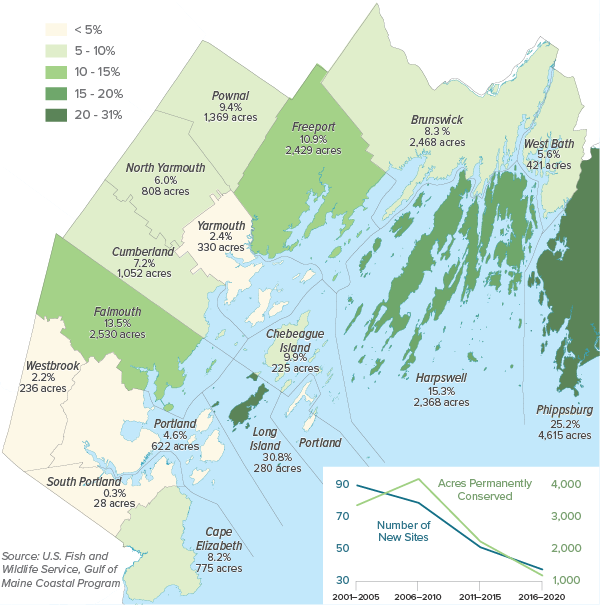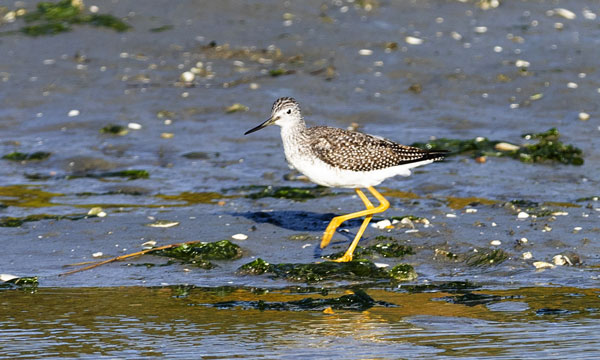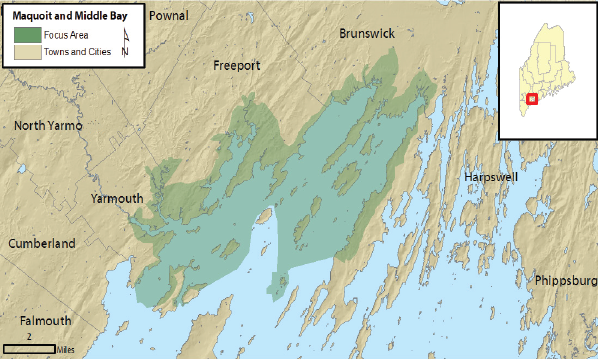Fourteen Percent of Land in Casco Bay's Watershed Has Been Permanently Conserved
In Coastal Communities, Conservation Land Approaches Ten Percent
WHY IT MATTERS
Conservation land is land that is permanently protected from development and generally remains in a natural state for fish, wildlife, and their habitat, or provides protection for other land values such as agriculture and forestry. Typically it allows for low-impact recreation but does not include land that is predominantly recreational such as ball fields or playgrounds. Keeping track of conservation lands over time helps illustrate the level of success conservation partners have had in protecting land. The actual rate of protection may reflect the availability of funding sources and the pace of residential and commercial development.
Throughout Casco Bay’s watershed, and particularly in proximity to Portland, land is being developed in response to demand for residential housing and commercial or industrial property, fueled by changing patterns in where people work and live. Setting aside a network of natural areas in perpetuity is important to protect clean water, conserve ecological communities, enhance climate resilience, sustain working forests and farms, and provide current and future generations with access to open space and outdoor recreation.
STATUS
In the Casco Bay watershed, 81,621 acres of land had been permanently protected as of December 2019. This amounts to 14.2 percent of the total watershed land area and represents an additional 6,480 acres since 2014. The impressive increase reflects the tireless work of land trusts and other conservation partners.Increase in Permanent Conservation Land in Casco Bay Watershed
Land Area Permanently Conserved in Coastal Communities

Maquoit and Middle Bay Conservation Focus Area
The sheltered coves and peninsulas between the Royal River estuary and Harpswell Neck provide an “extraordinary array of ecological values,” according to the State of Maine Beginning with Habitat program. This area of Casco Bay includes salt marshes, mudflats, eelgrass beds, and over a dozen islands.
The interconnected landscape supports numerous “rare animals as well as fish, invertebrates, waterfowl, wading birds, and other wildlife, including commercially valuable species,” providing ecological and economic benefits to the Bay and its communities.
The State’s designation of this area as a Conservation Focus Area has helped to concentrate collaborative efforts to protect this special place and build regional awareness of its importance.


Threats / challenges
- The forces that are driving development are fundamentally regional in nature. And yet, the primary entities that work to protect land are operating at smaller scales—at either a local or multi-town level. As a result, regional development, land use, and transportation planning can be disconnected from land protection needs.
- The Casco Bay region lacks a set of shared, regional priorities for land protection, as well as regional conservation funding mechanisms to help address the higher cost of conservation work in this part of the state.
- There are challenges with tracking and mapping conservation land at a regional scale. For example, municipally owned properties may not be defined as protected, despite long-term management practices.
- The pace of land conservation is limited by costs, particularly during periods with strong real estate markets. Long-term stewardship obligations can also constrain the pace of conservation.
View a PDF version of this page that can be downloaded and printed.
View references, further reading, and a summary of methods and data sources.
STATE OF CASCO BAY
Drivers & Stressors
What’s Affecting the Bay?
Human Connections
What’s Being Done?
If you would like to receive a printed State of Casco Bay report, send an email request to cbep@maine.edu.
This document has been funded by the U.S. Environmental Protection Agency under Cooperative Agreements #CE00A00348-0 and #CE00A00662-0 with the University of Southern Maine.
Suggested citation: Casco Bay Estuary Partnership. State of Casco Bay, 6th Edition (2021).
Photo at top of page: Royal River Conservation Trust